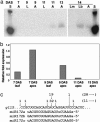microRNA172 down-regulates glossy15 to promote vegetative phase change in maize
- PMID: 15958531
- PMCID: PMC1166634
- DOI: 10.1073/pnas.0503927102
microRNA172 down-regulates glossy15 to promote vegetative phase change in maize
Abstract
Shoot development in many higher plant species is characterized by phase change, where meristems and organs transition from one set of identities to another. The transition from a juvenile to adult leaf identity in maize is regulated by the APETALA2-like gene glossy15 (gl15). We demonstrate here that increasing gl15 activity in transgenic maize not only increases the number of leaves expressing juvenile traits, but also delays the onset of reproductive development, indicating that gl15 plays a primary role in the maintenance of the juvenile phase. We also show that the accumulation of a maize microRNA homologous to miR172 increases during shoot development and mediates gl15 mRNA degradation. These data indicate that vegetative phase change in maize is regulated by the opposing actions of gl15 and miR172, with gl15 maintaining the juvenile phase and miR172 promoting the transition to the adult phase by down-regulation of gl15. Our results also suggest that the balance of activities between APETALA2-like genes and miR172 may be a general mechanism for regulating vegetative phase change in higher plants.
Figures



References
-
- Lawson, E. J. R. & Poethig, R. S. (1995) Trends Genet. 11, 263-268. - PubMed
-
- Kerstetter, R. A. & Poethig, R. S. (1998) Annu. Rev. Cell Dev. Biol. 14, 373-398. - PubMed
-
- Goebel, K. (1900) Organography in Plants. Part I. General Organography (trans. Balfour, I. B.) (Clarendon, Oxford) (English).
-
- Allsopp, A. (1967) Adv. Morphog. 6, 127-171. - PubMed
-
- Poethig, R. S. (2003) Science 301, 334-336. - PubMed
MeSH terms
Substances
Associated data
- Actions
LinkOut - more resources
Full Text Sources
Other Literature Sources

